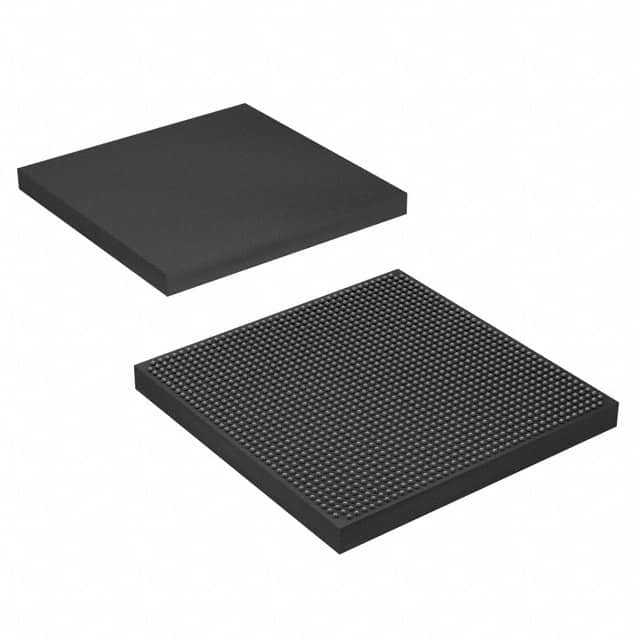Consulte las especificaciones para obtener detalles del producto.

5SGXMA3K2F40C3N
Product Overview
- Category: Field Programmable Gate Array (FPGA)
- Use: Digital logic circuits, signal processing, and system integration
- Characteristics: High-performance, reconfigurable, programmable, and flexible
- Package: BGA (Ball Grid Array)
- Essence: Advanced integrated circuit for customizable digital designs
- Packaging/Quantity: Single unit per package
Specifications
- Manufacturer: Intel Corporation
- Family: Stratix V
- Device: 5SGXMA3K2F40C3N
- Technology: 28nm
- Logic Elements: 2,530,000
- Embedded Memory: 8,062,464 bits
- DSP Blocks: 3,288
- Maximum User I/Os: 1,280
- Operating Voltage: 0.87V - 0.98V
- Operating Temperature: -40°C to 100°C
Detailed Pin Configuration
The 5SGXMA3K2F40C3N FPGA has a complex pin configuration with multiple I/O banks, power supply pins, and configuration pins. For the detailed pinout diagram and description, please refer to the manufacturer's datasheet.
Functional Features
- High-speed performance: The FPGA offers fast data processing capabilities.
- Reconfigurability: It allows users to modify the design after manufacturing.
- Flexibility: Supports various communication protocols and interfaces.
- Integration: Can incorporate multiple functions into a single chip.
- Low power consumption: Optimized power management features.
- Security: Provides built-in security mechanisms to protect designs.
Advantages and Disadvantages
Advantages: - Customizability: Users can tailor the FPGA to their specific requirements. - Time-to-market: Allows rapid prototyping and quick design iterations. - Cost-effective: Eliminates the need for custom ASIC development. - Scalability: Can be used in a wide range of applications.
Disadvantages: - Complexity: Designing for FPGAs requires specialized knowledge. - Power consumption: Compared to dedicated ASICs, FPGAs consume more power. - Limited performance: Not suitable for applications requiring extreme speed.
Working Principles
The 5SGXMA3K2F40C3N FPGA operates based on the principles of configurable logic blocks (CLBs), interconnect resources, and programmable routing. The CLBs contain look-up tables (LUTs) and flip-flops that can be configured to implement desired logic functions. The interconnect resources allow communication between different blocks, enabling data flow within the FPGA. The programmable routing allows users to define the connections between various components.
Detailed Application Field Plans
The 5SGXMA3K2F40C3N FPGA finds applications in various fields, including:
- Communications: Used in wireless base stations, network routers, and optical networking equipment.
- Industrial Automation: Enables control systems, robotics, and machine vision applications.
- Medical Devices: Utilized in medical imaging, patient monitoring, and diagnostic equipment.
- Aerospace and Defense: Supports radar systems, avionics, and secure communications.
- High-Performance Computing: Used in supercomputers, data centers, and scientific simulations.
Detailed and Complete Alternative Models
- Xilinx Virtex UltraScale+ VU9P
- Lattice Semiconductor ECP5-85
- Microsemi SmartFusion2 M2S150
- QuickLogic EOS S3
- Achronix Speedster7t AC7t1500
These alternative models offer similar functionalities and can be considered as alternatives to the 5SGXMA3K2F40C3N FPGA.
Note: The content provided above is a sample structure for an encyclopedia entry. Additional information and details can be added as per requirements.
Enumere 10 preguntas y respuestas comunes relacionadas con la aplicación de 5SGXMA3K2F40C3N en soluciones técnicas
Sure! Here are 10 common questions and answers related to the application of 5SGXMA3K2F40C3N in technical solutions:
Q: What is the 5SGXMA3K2F40C3N FPGA used for? A: The 5SGXMA3K2F40C3N is a Field-Programmable Gate Array (FPGA) that can be used for various applications such as high-performance computing, networking, and signal processing.
Q: What are the key features of the 5SGXMA3K2F40C3N FPGA? A: Some key features include a large number of logic elements, high-speed transceivers, embedded memory blocks, and support for various communication protocols.
Q: Can the 5SGXMA3K2F40C3N FPGA be reprogrammed? A: Yes, FPGAs are designed to be reprogrammable, allowing users to modify the functionality of the device even after it has been deployed in a system.
Q: How can the 5SGXMA3K2F40C3N FPGA be programmed? A: The 5SGXMA3K2F40C3N FPGA can be programmed using hardware description languages (HDLs) such as VHDL or Verilog, or through graphical programming tools provided by the FPGA manufacturer.
Q: What are some typical applications of the 5SGXMA3K2F40C3N FPGA? A: This FPGA can be used in applications like high-frequency trading, software-defined networking, radar systems, image and video processing, and data center acceleration.
Q: Does the 5SGXMA3K2F40C3N FPGA support high-speed communication interfaces? A: Yes, it supports high-speed transceivers that can handle protocols like PCIe, Ethernet, USB, and others, making it suitable for applications requiring fast data transfer.
Q: Can the 5SGXMA3K2F40C3N FPGA interface with external memory devices? A: Yes, it has embedded memory blocks and also supports various external memory interfaces such as DDR3, DDR4, QDR, and RLDRAM, enabling efficient data storage and retrieval.
Q: What is the power consumption of the 5SGXMA3K2F40C3N FPGA? A: The power consumption of an FPGA depends on the design and utilization. The datasheet provides detailed information about power requirements and guidelines for power management.
Q: Are there any development kits available for the 5SGXMA3K2F40C3N FPGA? A: Yes, the FPGA manufacturer typically provides development kits that include evaluation boards, software tools, documentation, and example designs to help users get started with the FPGA.
Q: Can the 5SGXMA3K2F40C3N FPGA be used in safety-critical applications? A: While FPGAs can be used in safety-critical applications, additional measures need to be taken to ensure functional safety, such as implementing redundancy, fault detection, and error correction techniques.
Please note that the specific details and answers may vary depending on the context and requirements of the application.

